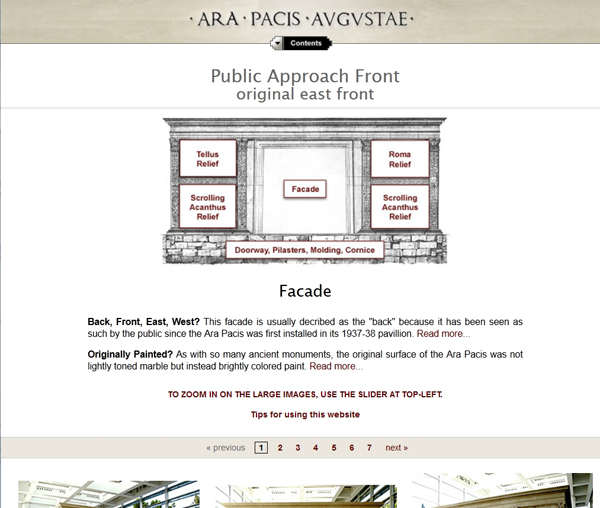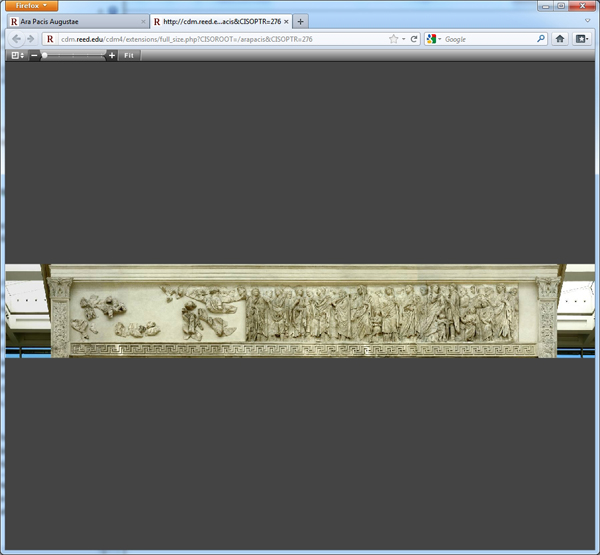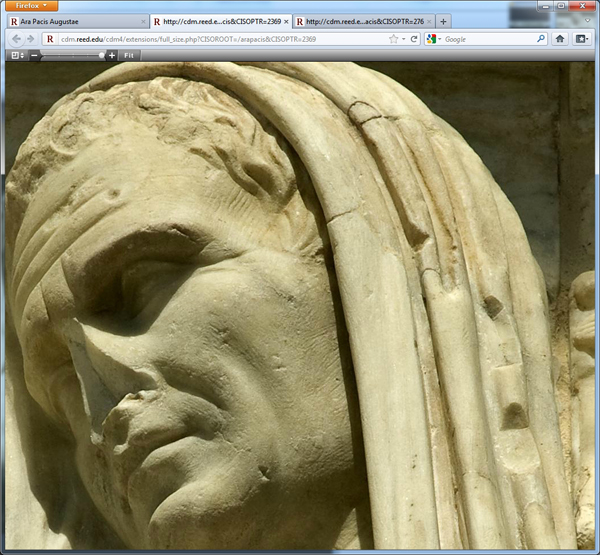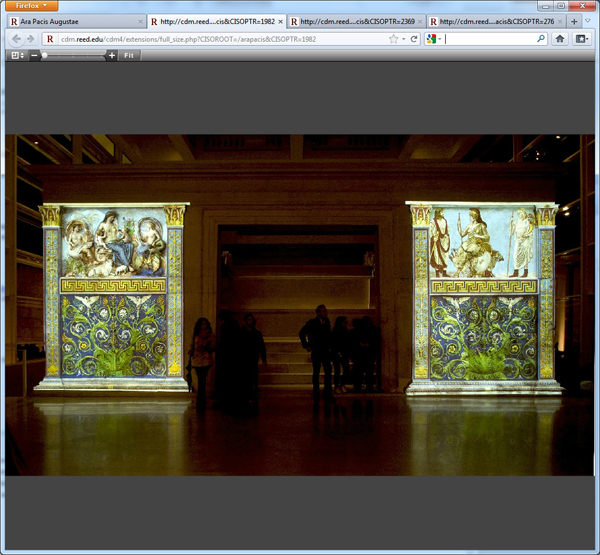

| Vol. XXIV, No. 3 | January, 2012 |
Articles in Vol. XXIV, No. 3
Website Review: Ara Pacis Augustae
In-depth visual documentation.
-- Martin Beckmann
Websites as Stable Resources
Too many have disappeared.
-- Harrison Eiteljorg, II
§ Readers' comments (as of 2/8/2010)
Website Review: Dikili Tash
A good beginning, but only a beginning.
-- Andrea Vianello
Evolving Web Standards: a Blessing and a Curse
Why eliminate good, useful tags?
-- Harrison Eiteljorg, II
§ Readers' comments (as of 2/3/2010)
Project Publication on the Web - Addendum
Making it clear that a final report is just that.
-- Harrison Eiteljorg, II
To comment on an article, please email
the editor using editor as the user-
name, csanet.org as the domain-name,
and the standard user@domain format.
Index of Web site and CD reviews from the Newsletter.
Limited subject index for Newsletter articles.
Direct links for articles concerning:
- the ADAP and digital archiving
- CAD modeling in archaeology and architectural history
- GIS in archaeology and architectural history
- the CSA archives
- electronic publishing
- use and design of databases
- the "CSA CAD Layer Naming Convention"
- Pompeii
- pottery profiles and capacity calculations
- The CSA Propylaea Project
- CSA/ADAP projects
- electronic media in the humanities
- Linux on the desktop
Search all newsletter articles.
(Using Google® advanced search
page with CSA Newsletter limit
already set.)
Website Review: Ara Pacis Augustae
Martin Beckmann
(See email contacts page for the author's email address.)
Ara Pacis Augustae
- URL: http://cdm.reed.edu/ara-pacis
- Authorship: Charles S. Rhyne (content) and Jason Parker (web design).
- Site host: Reed College.
- Peer review: None stated.
- Permanence: No information provided.
- Archival procedures: No information provided.
- Languages: Translations to Italian, German, French, Russian, Portugese, Spanish (both New World and Old World versions), Chinese, Japanese, and Korean are provided via Google. The translation pages create some navigation difficulties.1
The Ara Pacis Augustae (Altar of Augustan Peace) was dedicated in 9 BC in the Campus Martius, the wide flat plain to the north of the centre of Rome. It is most famous for the elaborately carved relief sculpture on the marble screen that surrounds the actual altar; the altar was accessible through doors in the west and east. The subject matter of the west and east faces of the screen is allegorical and mythological, including the Earth and an image of Aeneas. The north and south faces of the screen, unbroken by doorways, show two long processions (or two parts of one procession); these contain priests and other religious officials and also members of the imperial family, including Augustus himself. The fine classical style of the altar carvings epitomises Augustan art and has long been the subject of detailed study.
This website about the altar was created by Charles S. Rhyne, an emeritus professor of Art History at Reed College, and Jason Parker, an academic web specialist. Rhyne's main art-historical interests lie in the fields of John Constable and in the art of the Indians of the Northwest Coast; in addition he has numerous publications on art conservation and on digital imagery in art historical research. His interest in the Ara Pacis appears to stem from these latter two foci, formed over a number of years spent teaching an introductory humanities course on the subject. Rhyne appears not to have published any academic papers on the Ara Pacis.
The stated goal of the site is to make available a larger group of images of the Ara Pacis than can be found in any other single publication. By doing so the "web site attempts to provide in-depth visual documentation in support of the in-depth scholarly publications"2 on the Ara Pacis. The stated intended audience is university students and faculty. The core of the website's content is a set of photographs taken by Rhyne in the new Ara Pacis Museum between 2008 and 2010. These are supplemented by various images scanned from publications.
The site is fairly easy to navigate. A convenient "Contents" icon at the top of every page allows easy browsing of the main categories. These are: the Augustan Altar (where the photographs are mainly to be found); Published Images; Architecture (of the Museum building and the surrounding Piazza); Maps and Aerial Views; and Text.

Fig. 1 – Home screen, showing menu accessible throughout the website
by hovering the cursor over the "Contents" icon.
The interface in the main altar section is via icons placed on an image of one of the main faces of the altar screen. Large thumbnails of the individual photographs are then arranged below.

Fig. 2 – East side of the altar, showing interface through icons.
Composite images of the two long friezes allow a user to scroll through the entire length of the processions. This is a useful image format, and zooming in on this image yields sufficient detail to discern facial features and hairstyles. Unfortunately these composites are not linked to individual detailed photographs. If a user wishes to see any part of the frieze in greater detail, he or she has to return to the main screen and seek out the detailed photographs one by one.

Fig. 3 – South frieze, composite image.
When a user clicks on an image, a new browser tab is opened and the image is displayed in that tab. There the user can zoom in on the image (most of the time) using a slider in the upper left corner of the frame, and he/she can drag the image around the frame using the cursor. The introductory text suggests that this system of automatically opening each image in a new tab was chosen in order to facilitate comparison of two or more images. However, once in this new tab the user cannot see two images at once; to select another image he/she must go back to the original tab and click a new image. With a wide screen a user could right-click the thumbnail and open the image in a new window for side-by-side comparison. In a section of "tips" for using the website the authors mention that the images will open differently depending on what browser one is using and what settings are used. No indication is given as to what browser might be optimal or what settings to change and how. Tech-savvy users presumably don't need this, but this reviewer would have appreciated it, since I was left wondering if I was getting the most out of the site or not.
The site contains over a thousand images. Most of these are recent photographs of the altar screen and the interior; added to this are photographs of associated objects (e.g., the model of the Campus Martius in the current Ara Pacis museum) and scans from selected books and articles. Unfortunately, moiré patterns are sometimes visible on scanned images; in the worst cases these patterns, which change depending on the degree of magnification, make the image difficult or impossible to see clearly at many levels of resolution. Some of these images are from old publications presumably out of copyright; others are not, and it is not clear what the frequent citation "reproduced with appreciation" means with respect to the numerous images scanned from various publications, both old and new.
Most of the individual photos that make up the core of the website's content have been taken from floor-level in the museum and thus show the expected distortion resulting from this viewpoint. On the other hand, the fact that most photos were made in daylight and in colour gives the user a good impression as to what the actual monument looks like. This may seem like an obvious statement, but given that most published photographs are in black-and-white it is easy for students to form an incorrect picture of the altar's material and appearance. It also serves to give an impression of how an ancient Roman observer in the time of Augustus might have viewed the monument. Individual photos of the frieze are generally very good in quality and are often sharp enough that tool marks are clearly visible when the image is magnified (compare figures 4 and 5).

Fig. 4 – Photograph of head of Agrippa.

Fig. 5 – Photograph from figure 4 enlarged to maximum possible.
Tool marks are clearly visible on the face of Agrippa, particularly
rasp marks on his cheeks and the partly-obliterated remains of fine
tooth chisel marks on his temple.
Also novel and useful are a number of photographs taken at night of recent attempts to illuminate the altar in colour, a process designed to give the viewer an impression of how the altar may have appeared if painted (a common treatment of relief sculpture in ancient times).

Fig. 6 – Nighttime photograph of the east face of the altar,
illuminated to show how it may have appeared if painted.
The text varies in focus and placement. Much information is contained in the "Text" section of the website, but much also in the captions appended to the individual photographs. In the main text section there is very little treatment of the traditional preoccupations of Ara Pacis researchers such as the identification of the various members of the procession; this information is instead addressed in many photo captions. The longest single section of text (under the section heading "Chronology") is devoted to a history of the monument, reflecting Rhyne's strong interest in conservation and providing a very detailed discussion of the rediscovery of the altar from the 16th century to modern times. Rhyne notes major works of scholarship along the way, but his focus is clearly on the history of the monument, its recovery, and its display. As such this website offers a lot of information not easily found elsewhere. His eye for restoration is sharp, and his comments on modern additions to the frieze (found mainly in the photo captions) make very worthwhile reading.
References to various scholarly ideas (and, especially in the chronology section, to ancient sources) are frequent, but notes or other specific attribution to particular publications are rare. This will pose a problem for students trying to determine the ultimate source of the ideas and evidence presented by Rhyne. On the other hand, a bibliography is provided that is not only substantial, but also partly annotated with one or two paragraphs describing the contents of about half of the bibliography's entries. This will be a useful tool for serious students of the monument. A thoughtful addition is the provision of links to online versions of these sources where available; I was very happy to find a link to a complete online text of Peter Rockwell's The Art of Stoneworking on the website of The Digital Sculpture Project, an important recent book on ancient carving techniques but out of print for a number of years.
In sum, the Ara Pacis Augustae website provides access to a large and useful collection of images of a very important Roman monument, very many of high quality. These are a useful supplement to images available in traditional publications, which themselves are represented by scanned portions of selected books and articles that give the user a good idea of their contents. The text is particularly strong in the areas of the history of the altar's rediscovery, restoration, and display. The whole site is relatively easy to navigate, and it is possible quickly to form an impression of the site's overall content. I expect that the site will prove most useful to advanced students as a guide to the monument, its history, and the history of its scholarship.
-- Martin Beckmann
Notes:
1. For a critical look at Google® translations, see CSA Newsletter, Google® Translations section in "Miscellaneous News Items," csanet.org/newsletter/fall11/nlf1106.html" XXIV,2; September, 2011. Return to text.
2. cdm.reed.edu/ara-pacis/preface.php, last accessed December, 2011. Return to text.

All articles in the CSA Newsletter are reviewed by the staff. All are published with no intention of future change(s) and are maintained at the CSA website. Changes (other than corrections of typos or similar errors) will rarely be made after publication. If any such change is made, it will be made so as to permit both the original text and the change to be determined.
Comments concerning articles are welcome, and comments, questions, concerns, and author responses will be published in separate commentary pages, as noted on the Newsletter home page.